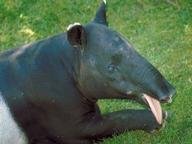Quiz Answer Key and Fun Facts
1. Pam wakes up like she does everyday in her home in Zambia. She unrolls herself and looks up at the sun, yawning. It's going to be another busy day.
Now, Pam always knew she was different. She isn't like a sloth, in that she doesn't belong to the families of Edentata or Xenarthra. She is in fact a Pholidota, and her genus is Manis. Which of these features means that Pam is similar to an edentate?
2. Pam lives in Zambia, and so she is an old-world mammal. She has often dreamed of travelling the world, but which of the following places would Pam least likely see other pangolins?
3. Pam is very proud of her species name, Manis tricuspis. She is a small-scaled tree pangolin, and darned proud of it! She is proud of being called a pangolin too, but she does not know what it means. What does 'pangolin' mean, and what language is it from?
4. Pam has a long tongue, like her fellow toothless relatives. In fact, some people say she looks like a scaly tamandua. Now, Pam has a very long tongue, and she is unique in the animal kingdom as her tongue is actually anchored to a pair of bones. Which pair?
5. Pam knows that her family goes a long way back, and that they could be found in what is now Germany. In fact, a fossil pangolin has been found in Germany, and it is said to date from the Eocene period. What was the name given to this fossil pangolin?
Hint: Pangolins are part of the genus Manis, and the fossil dates from the Eocene period.
6. The first thing that Pam wants to do today is find food. As today is just like every other day, she'll do what she normally does (makes sense). Where will a small-scaled tree pangolin look for food, though?
7. After her breakfast, Pam loves to go down to the water and have a drink. While she's there, she checks out her sexy, arboreal physique in the reflective pool. She looks at her tail, and just knows she has something special. She has more of these than any other mammal, in fact. What are 'these'?
8. Pam, the African pangolin, sometimes gets maternal urges. She is a solitary animal until it comes to mating, and then she is a wild woman! How many offspring does she normally have in one litter?
9. Pangolins are very complex animals. Not only do they have scent glands like a skunk, they can also walk on all fours or on two legs. In fact, pangolins can run at speeds of up to three miles per hour when they are on their hind legs.
10. It's been one heck of a day for Pam, and she has found a lot out about herself and her ancestors. It's been very tiring, so as an arboreal pangolin, what does our ravishing heroine do when she wants to go to sleep?
Source: Author
Flynn_17
This quiz was reviewed by FunTrivia editor
crisw before going online.
Any errors found in FunTrivia content are routinely corrected through our feedback system.
